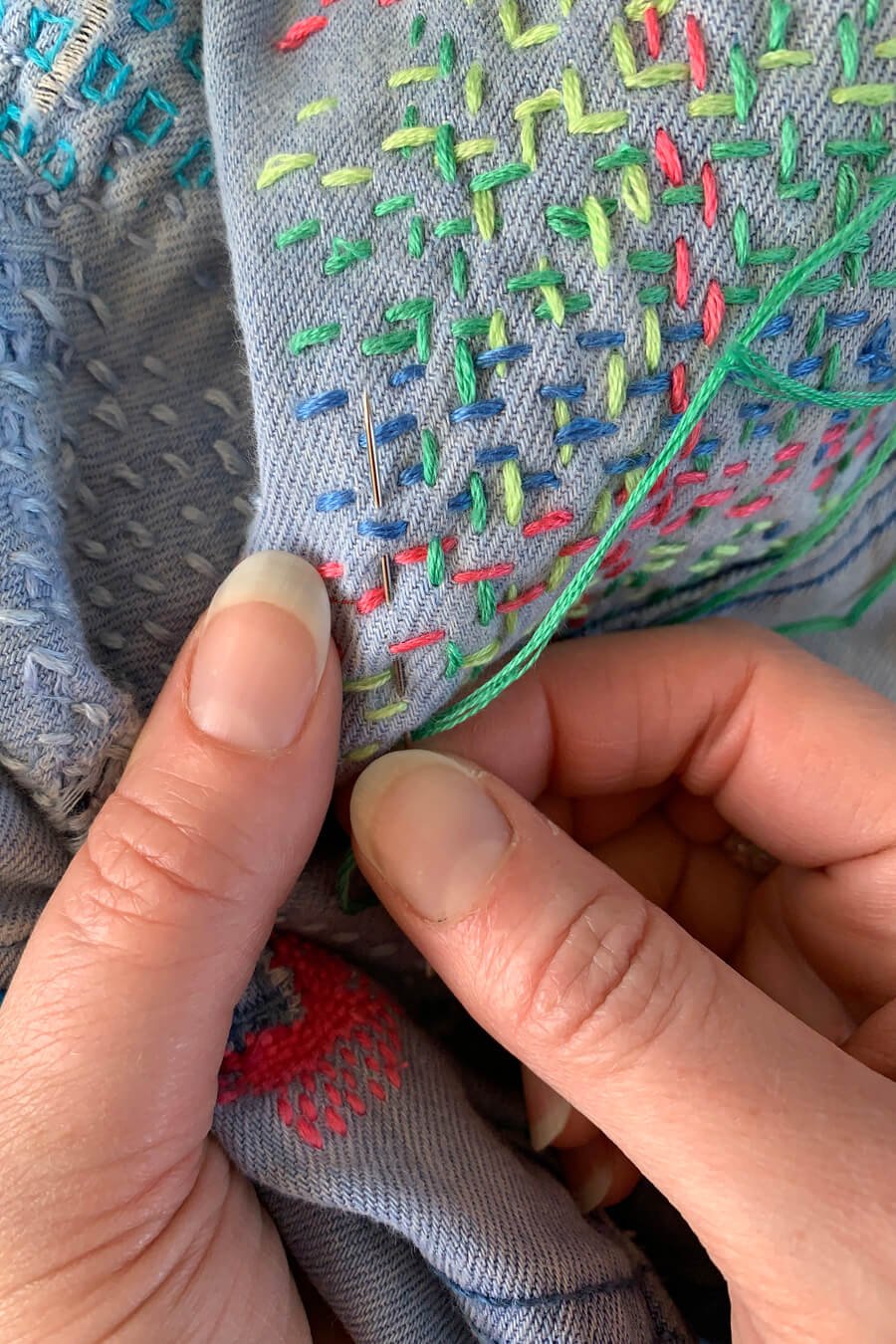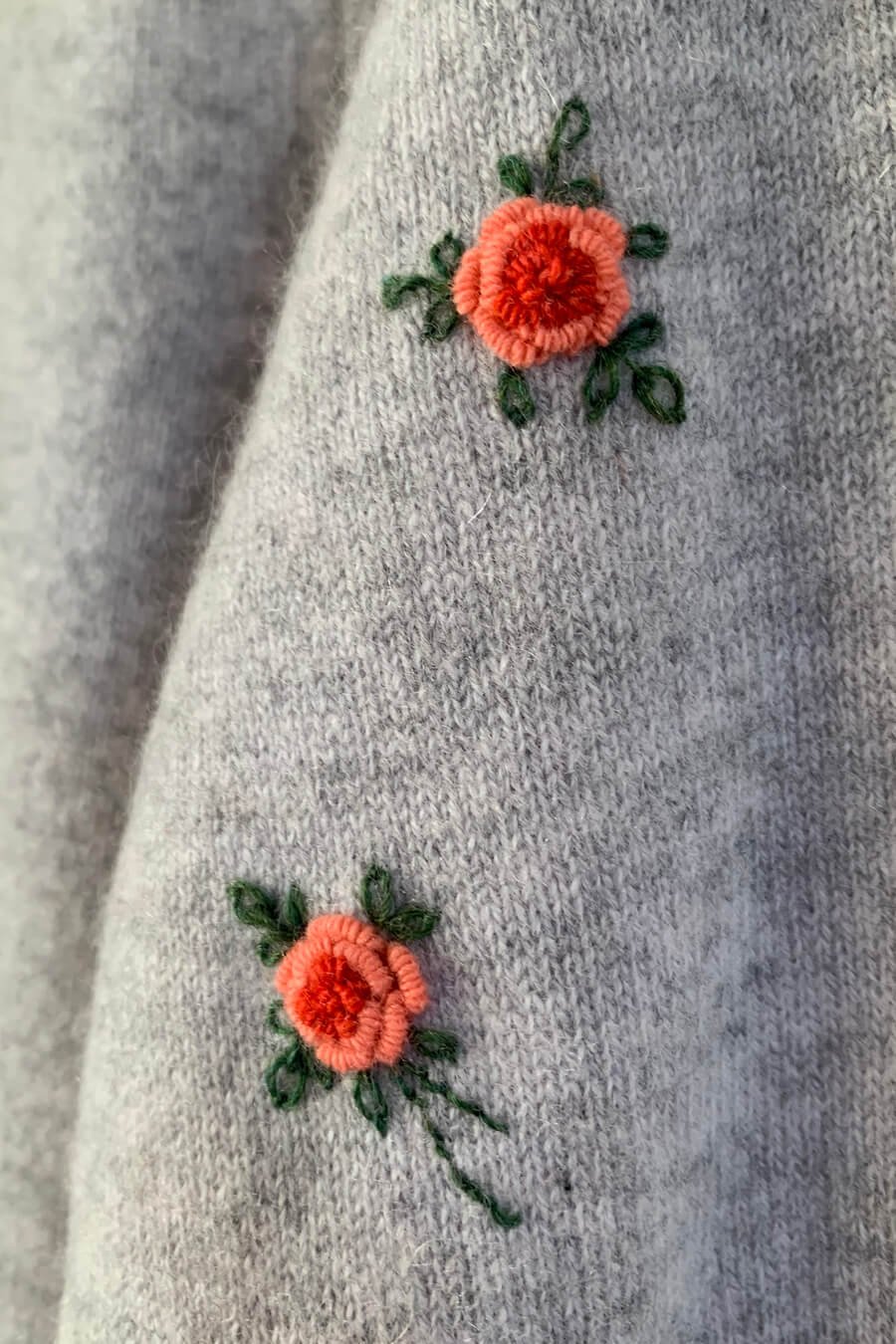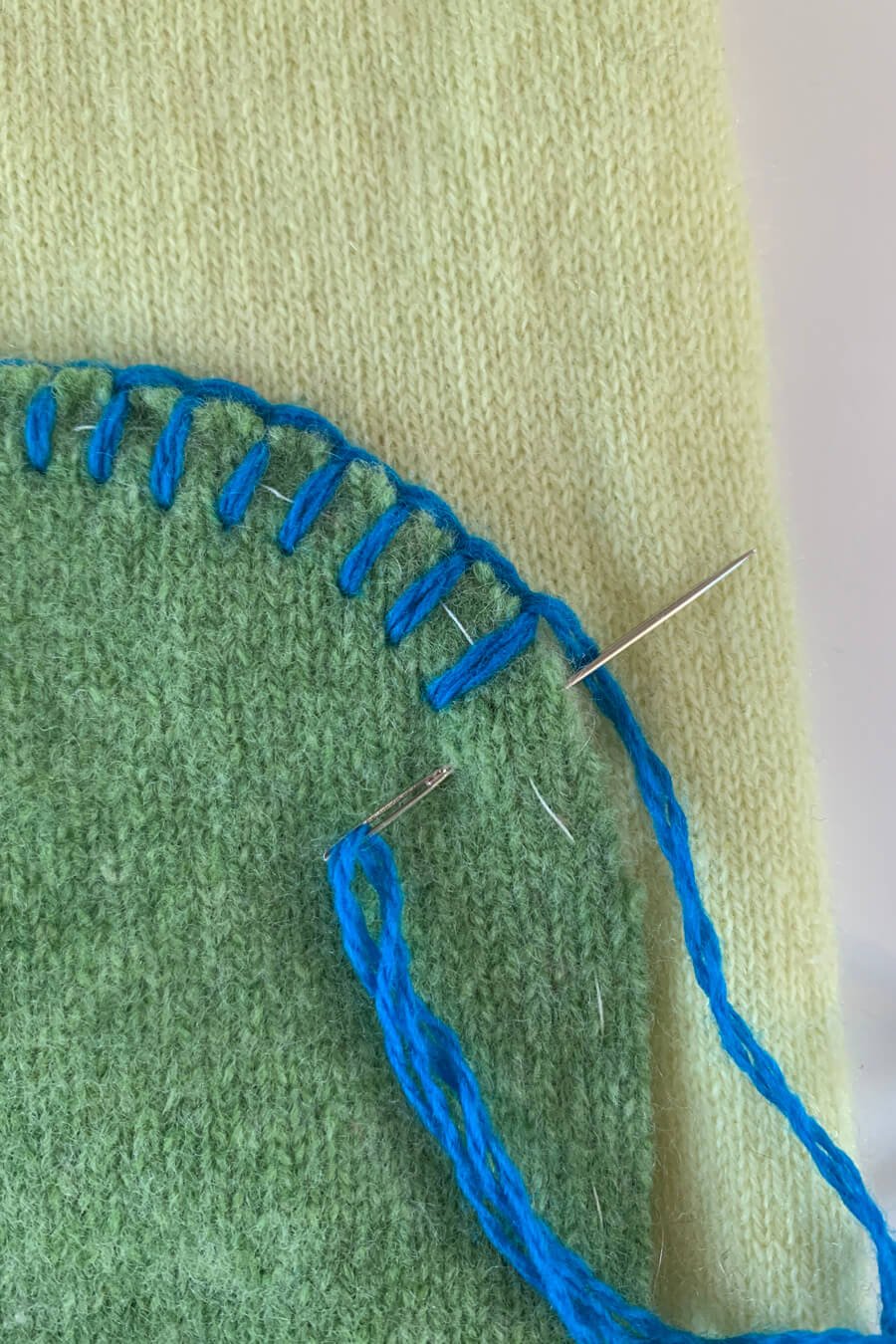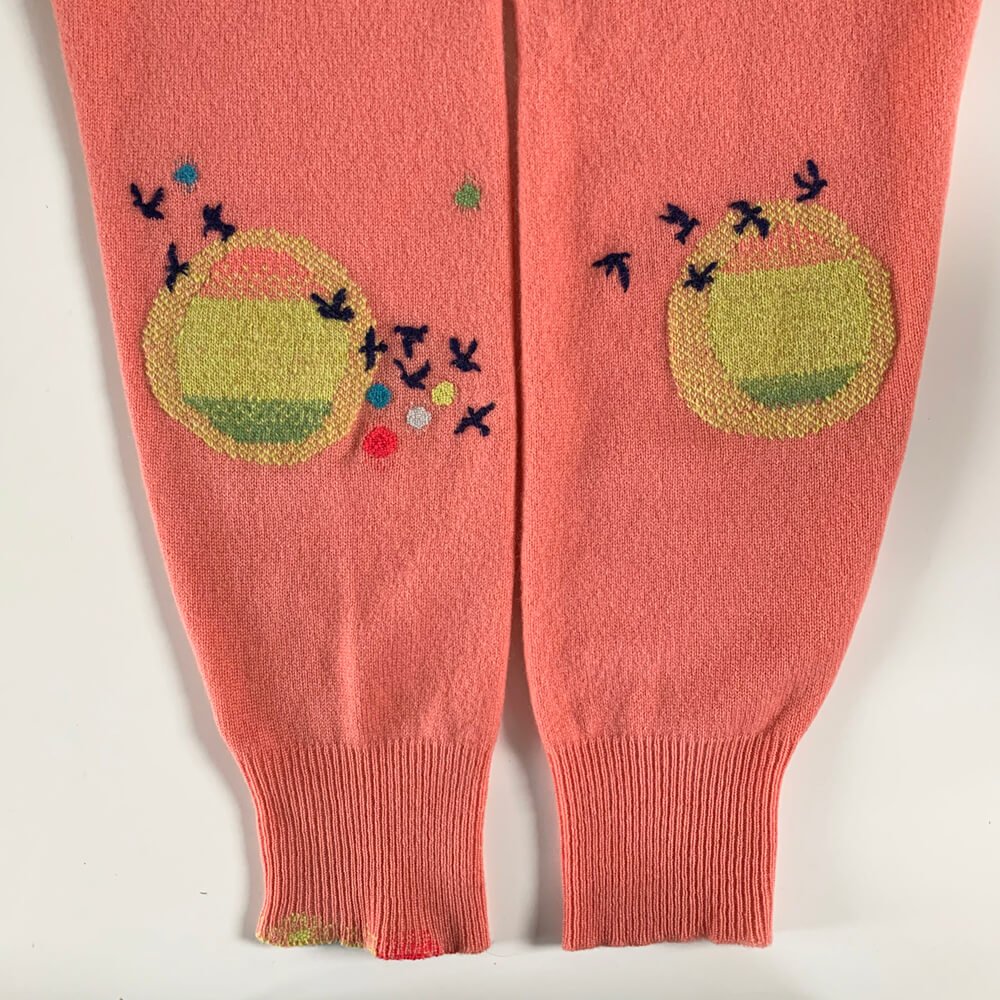Different Types of Embroidery Stitches
Embroidery is a great way to make your visible mending more creative, or to customise your wardrobe to make old garments feel like new. Using embroidery to cover up my first attempts at darning (which weren’t very polished at the time) is how I first fell in love with visible mending. I found it was a way to use the skills that I had and make my repairs creative, and I’ve been hooked on mending ever since.
Having a few different types of embroidery stitches and repair techniques at your disposal is really useful when it comes to visible mending. It allows you more freedom and creativity, and more options to make the most of the opportunity each hole provides! This is also the reason I’ve included a chapter on embroidery in my book, ‘Visible creative mending for knitwear’. I wanted to share the stitches I love to help you to be creative with for your own repair projects.
The key to becoming confident and creative with any technique is to practice it, play about with it, and try things out. Start simple, and experiment!
Embroidery Stitches for Visible Mending and Repairs
There are many different embroidery stitches that are great to use for visible mending, and lots of them are perfect for beginners.
Running Stitch
Running stitch a really useful stitch to know and very simple to do. I’m not quite sure it it counts as an embroidery stitch, but you can certainly use it as one! It’s a simple in and out stitch which can be done in a straight line or a curve. I often use it to join two pieces of fabric together. You can vary the size of stitches, and vary the even quality of them too. You could have small even stitches for example, or bigger less even ones (see the jeans below)- play about with it!
Running stitch is working by the needle going in and out of the fabric. You can load multiple stitches on your needle at once to make it quicker.
A patch is stitched onto the inside of these jeans with running stitch, used creatively to make it more secure and decorative.
I often use big, loose running stitches to tack a fabric patch in place so it doesn’t move while I add whatever other stitching I have planned onto it. Then I remove my tacking stitches when I’m finished.
Sashiko, a Japanese mending technique, relies on very neat running stitches that are carefully spaced and placed to come together as a pattern. Lines of running stitch go side to side and up and down. Being careful of the placement of stitches then forms patterns.
Sashiko inspired repairs (the patch is on the inside, being held in place by this stitching). Lines of running stitch carefully working together to create different patterns.
Straight Stitch
Straight stitch is an absolute favourite of mine. It’s incredibly simple, and you can use it to create all kinds of patterns and designs. It’s simply a stitch in a straight line.
It can be used very similarly to satin stitch, but I think where satin stitch (lots of straight lines placed evenly side by side and touching, useful for filling in areas) is quite rigid and uniform, straight stitch can be a bit freer and used more creatively.
Fly Stitch
Fly stitch is a great embroidery stitch to learn as it can be varied in so many ways and can be really creative. Use the stitches close together like the examples below, or space them out. Fly stitch can be varied in size, used uniformly or not, to create very different effects. This is one of the stitches I’ve covered in my book and in my embroidery stitch video tutorial.
Fly stitch is created in a way that’s not too dissimilar to daisy stitch. Daisy stitch is another stitch I use fairly regularly for flowers and leaves, and is formed by a loop stitch held in place by a little stitch that goes over the top end of the loop.
French Knots and Bullion Stitch
You’ll already have seen french knots in a few of the examples above- I love them for adding texture and dots! Bullion stitch is a long version, and also great for adding texture. Both are created by wrapping the yarn around the needle before pulling the yarn through. I’ve had lots of people tell me they’ve really struggled to get the hang of these knots, but they’re not scary once you know how, and my embroidery video tutorial will have you making them with confidence!
Different Embroidery Stitches for Sewing on Elbow Patches
Using different embroidery stitches to sew on elbow patches can make them more exciting and creative. Adding an elbow patch over a hole can be a much faster way of fixing it than darning it or reinforcing it with swiss darning. While darning and swiss darning can be really beautiful, they are time consuming, so this is a way to still be creative with your mending but speed it up a bit!
Blanket Stitch
Blanket stitch is a great embroidery stitch to know for visible mending. Use it for edges, sewing on elbow patches, for keeping holes but making them secure, and for decoration.
You can also connect rows of blanket stitch for a scotch darning like mend.
Herringbone Stitch
Herringbone stitch is another lovely stitch to use for sewing on elbow patches. The lines criss-cross over each other providing good covering over the edge and a lovely decorative effect.
I have recently created some knitted lambswool elbow patches. Some in plain colours, some with pattern, They are all lambswool, and felted slightly so they won’t come apart. These allow you to add a patch that will have some stretch to it, like your sweater or cardigan, and which you can sew on creatively and decorate if you wish!
Swiss Darning / Duplicate Stitch
Swiss darning, or duplicate stitch, has to be included here. I view it as a form of embroidery on knitwear, and it’s very relevant when it comes to repairing your knitwear too. I view it as embroidery when I use it to reinforce threadbare areas before they turn into holes. I can do this creatively, or invisibly (if I have the right yarn) and depending on what I choose, I can then work over it with other embroidery stitches.
Elbow repairs are a great opportunity for creativity, as they tend to be fairly large areas. Below you can see two different examples from my own wardrobe. The navy blue one is a work in progress. I’m choosing to reinforce these elbows in a design that works with the original darns on the sleeve. As it’s very bold already, I won’t add more embroidery to it once it’s finished.
The second example in orange has swiss darning as more of a base, and I’ve embroidered over parts of it and around it (using straight stitch). It’s hard to see in this photo, but there is also some subtly patterning within the swiss darning, but not so much that embroidering over it makes it too busy.
As with many of the embroidery stitches I’ve mentioned here, swiss darning can be both function and creative!
There are of course lots of other embroidery stitches that are useful too! Back stitch, and chain stitch are both useful stitches, and can be used to join to pieces of fabric together- either for seems or for adding patches. Stem stitch creates beautiful lines, great for outlines, and stems of flowers. Just because my embroidery taste tend to go towards florals, doesn’t mean your have to though!
If you’d like to learn some embroidery stitches, then there are step-by-step instructions in my book, and in my embroidery video tutorial.














